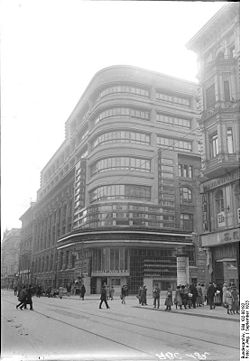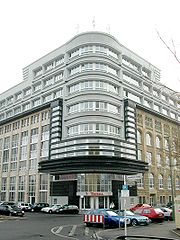
Mossehaus
Encyclopedia

Berlin
Berlin is the capital city of Germany and is one of the 16 states of Germany. With a population of 3.45 million people, Berlin is Germany's largest city. It is the second most populous city proper and the seventh most populous urban area in the European Union...
, renovated and with a corner designed by Erich Mendelsohn
Erich Mendelsohn
Erich Mendelsohn was a Jewish German architect, known for his expressionist architecture in the 1920s, as well as for developing a dynamic functionalism in his projects for department stores and cinemas.-Early life:...
in 1921-3.
The original Mosse building housed the printing press and offices of the newspapers owned by Rudolf Mosse
Rudolf Mosse
Rudolf Mosse was a German publisher and philanthropist.-Biography:Mosse was born in Grätz, Grand Duchy of Posen, as the son of Dr. Markus Moses, a noted physician...
, mainly liberal newspapers such as the Berliner Tageblatt
Berliner Tageblatt
The Berliner Tageblatt or BT was a German language newspaper published in Berlin from 1872-1939. Along with the Frankfurter Zeitung, it became one of the most important liberal German newspapers of its time.-History:...
. The sandstone-fronted
Sandstone
Sandstone is a sedimentary rock composed mainly of sand-sized minerals or rock grains.Most sandstone is composed of quartz and/or feldspar because these are the most common minerals in the Earth's crust. Like sand, sandstone may be any colour, but the most common colours are tan, brown, yellow,...
historicist 1901 building by Cremer & Wolffenstein
Cremer & Wolffenstein
The Cremer & Wolffenstein architecture firm was founded in 1882 by Richard Wolffenstein and Wilhelm Cremer and existed up to the death of its two founders. During the so-called Gründerzeit in Berlin, the years of rapid industrial expansion in Germany at the end of 19th century, they were a...
was badly damaged in 1919, during the Spartacist uprising
Spartacist uprising
The Spartacist Uprising , also known as the January uprising , was a general strike in Germany from January 5 to January 15, 1919. Its suppression marked the end of the German Revolution...
—held by the insurrectionists, it was laid siege by government troops.
In 1921, on the strength of his Einstein Tower
Einstein Tower
The Einstein Tower is an astrophysical observatory in the Albert Einstein Science Park in Potsdam, Germany built by Erich Mendelsohn. It was built on the summit of the Potsdam Telegraphenberg to house a solar telescope designed by the astronomer Erwin Finlay-Freundlich...
, Mendelsohn was hired to add extra storeys and a new entrance to the building. The new frontage made prominent use of aluminum and modern typography
Modern typography
Modern Typography was a reaction against the perceived decadence of typography and design of the late 19th century. It is mostly associated with the works of Jan Tschichold and Bauhaus typographers Herbert Bayer, Laszlo Moholy-Nagy, El Lissitzky and others....
, and the new upper floors were made from ferro-concrete
Reinforced concrete
Reinforced concrete is concrete in which reinforcement bars , reinforcement grids, plates or fibers have been incorporated to strengthen the concrete in tension. It was invented by French gardener Joseph Monier in 1849 and patented in 1867. The term Ferro Concrete refers only to concrete that is...
. The experimental nature of the structure led to a disaster during construction in 1923, when one of the slabs of the new extension fell into the newspaper offices which were still in use, killing 14 people.

Futurist architecture
Futurist architecture is an early-20th century form of architecture characterized by anti-historicism and long horizontal lines suggesting speed, motion and urgency. Technology and even violence were among the themes of the Futurists. The movement was founded by the poet Filippo Tommaso...
form, emphasised by the contrast with the Wilhelmine style below. It was perhaps the first example of a streamlined building, and hence a great influence on Streamline Moderne
Streamline Moderne
Streamline Moderne, sometimes referred to by either name alone or as Art Moderne, was a late type of the Art Deco design style which emerged during the 1930s...
. The effect on American architecture is perhaps unsurprising, as Mendelsohn's partner on the Mossehaus and the designer of the interiors was Richard Neutra
Richard Neutra
Richard Joseph Neutra is considered one of modernism's most important architects.- Biography :Neutra was born in Leopoldstadt, the 2nd district of Vienna, Austria Hungary, on April 8, 1892. He was born into both-Jewish wealthy family...
.
The building was very close to the Berlin wall
Berlin Wall
The Berlin Wall was a barrier constructed by the German Democratic Republic starting on 13 August 1961, that completely cut off West Berlin from surrounding East Germany and from East Berlin...
, so it became dilapidated after World War Two. Though Mossehaus was at one time the tallest non-church building in Berlin, it is now immediately dwarfed both by the Fischerinsel
Museum Island
Museum Island is the name of the northern half of an island in the Spree river in the central Mitte district of Berlin, Germany, the site of the old city of Cölln...
tower blocks on the former East side and the Axel Springer AG
Axel Springer AG
Axel Springer AG is one of the largest multimedia companies in Europe, with more than 11,500 employees and with annual revenues of about €2.9 billion. The Company is active in a total of 36 countries, including Hungary, Poland, the Czech Republic, Russia and Germany, France, Spain, Switzerland...
buildings on the former West. The building was restored in the 1990s.

